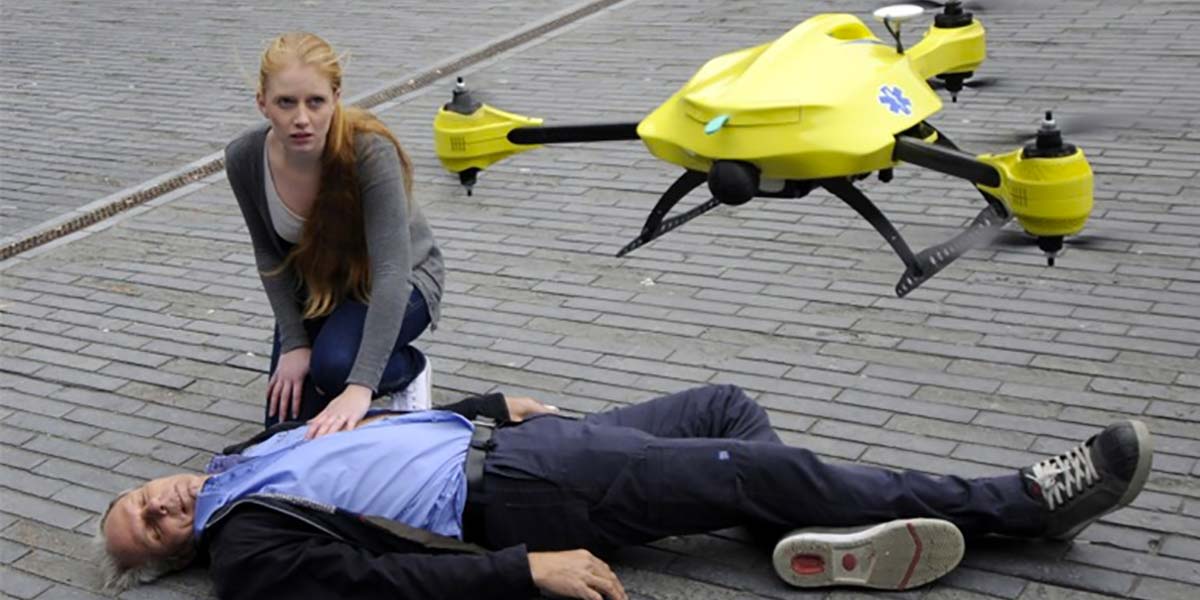
Servo Magazine ( December 2016 )
Robots of the Future
By Tom Carroll View In Digital Edition
While I was on vacation, I and happened to see two TV commercials presented right after each other touting robots and the future. One was by the job site, Indeed.com about booming jobs in the future of robotics. The other was by OppenheimerFunds, implying that people feel that robots can be inhuman, cold, and heartless as depicted in three scenes, and yet beautiful, as in another scene where a humanoid robot was shown helping a senior with her meal. The ad stated: "At OppenheimerFunds, we find beauty in disruption. We challenge perceptions about robots, revealing not only the investment opportunity, but how robots will change how we live for the better." All facets of life are now looking at robots for use in the future.
When you’re thinking of robots in the future, the first type that probably comes to mind is a bipedal humanoid servant robot, similar to what we’ve seen in the movies for many decades. Step aside from a whimsical wish of a home robot and imagine this scenario. You’re on a hike in the woods outside of your city and are hiking on a one meter wide path with a friend. Your friend suddenly tells you that he doesn’t feel well, and grabs his chest and struggles to sit down and recline against a tree. For a second, you don’t know what to do. Then, you remember that you downloaded an app on your phone called ‘Drone-Delivered AED.’ You finger through your apps and come to that particular one and hit the emergency button image.
An AED (Automated External Defibrillator) is a portable electronic device shown in use in Figure 1 that automatically diagnoses the life-threatening cardiac arrhythmias of ventricular fibrillation and tachycardia in a patient, and then is able to treat them through defibrillation (the application of electrical ‘shocks’ sent through the skin to stop the arrhythmia), allowing the heart to reestablish an effective rhythm.
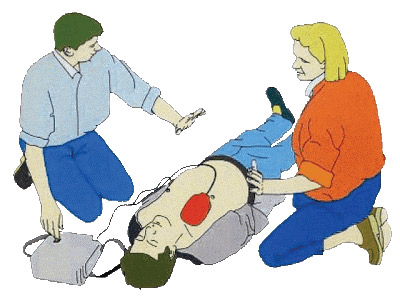
FIGURE 1. An AED defibrillator. Electrodes applied and hands away from the patient.
A few moments later, you hear a voice on your phone, “I notice that you are in a wooded area. Is the sky above you open for the drone that is coming your way?” You look up and reply, “Yes, it is about 25 meters open at the tree tops but the path is only a meter or two wide with brush on both sides.” “That is no problem, sir. The AED drone will soon be there. Keep your phone on and hold it above your head. The drone will land near you.” You then inform “the voice” that you downloaded and viewed the instruction video when you received the app, so you feel comfortable using the drone’s AED.
You soon hear the buzzing of the drone as it slowly lands on the clear pathway. The graph in Figure 2 shows just how critical it is to rapidly begin the defibrillation process, though few of us will be lucky enough to be near an AED if a heart attack occurs.
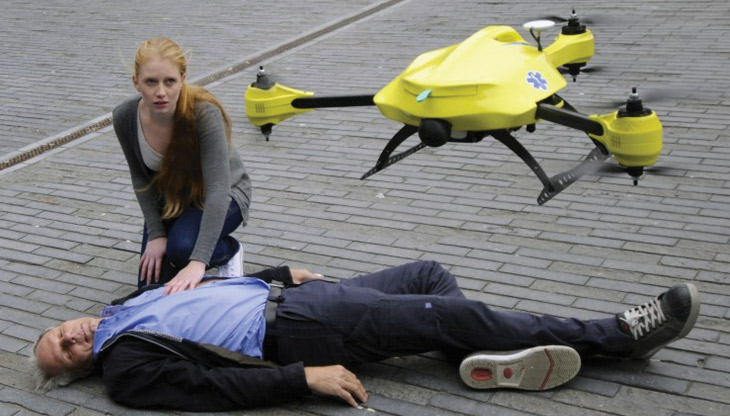
FIGURE 2. Ambulance drone responds to an emergency cardiac arrest call.
A voice emanates from the drone and you realize that the voice is a real person. “This is Jackie from Fire Station number 12. Move the drone over by the patient; the props will not move. Is the patient breathing?” “No,” you say, “but I’ve been performing CPR on him.” “That is good. Do you detect a heartbeat?” “I don’t think so, but I’m not sure.” “No problem, sir. Did you view the instruction video that comes with the app?” “Yes,” you tell her.
“Great. I will instruct you on how to pull out the electrodes and where to place them. Quickly remove the clothing from the patient’s chest. Pull out the two electrodes and remove the red-tabbed plastic covering from one electrode and stick it firmly about three centimeters or one inch above the patient’s right nipple. Remove the plastic from the second electrode and place it the same distance below the left nipple. Press them down to make sure they are stuck to the patient’s skin and stand back.“
As the AED is analyzing the patient’s condition, you hear a faint whine. You then hear the person tell you to depress the flashing red button, which you do. The AED begins to deliver a series of shocks to the patient and he reacts with a movement of the chest, but not quite as severe as you’ve seen in movies. You then see that there are no more whines as the AED is no longer charging and the patient’s eyes flutter and open.
“What happened?” he asks. “A flying robot came down from Heaven and brought you back to life,” you tell him. “Yeah, sure,” your friend says. About that time, you hear a helicopter landing in a clearing 100 meters off to the south. The voice from the drone tells you, “A rescue team is coming through the woods to where you are, sir. You did a good job with your friend.”
Could this Drone be in Our Future?
As there are so many categories of robots, I am concentrating mostly on medical and assistive types, and also delivery robot drones, but what a neat glimpse into the future. Too bad it couldn’t happen today. Except that, if researchers at the Delft University of Technology (also known as TU Delft in Delft, Netherlands) have their way, it could soon be a reality. I took some information from articles about the drone developed by the university and developed the above scenario, tossing in a few of my own ideas of the possibilities.
Trials have already been completed as the scene in Figure 3 attests to. A graduate student at the university has developed what is called an ‘ambulance drone.’ It can be delivered much more quickly to the scene of a sudden cardiac arrest than delivered by a fire department’s rescue ambulance or similar vehicle. This is especially the case when emergencies happen in a more rural or wooded area such as in my scenario here.
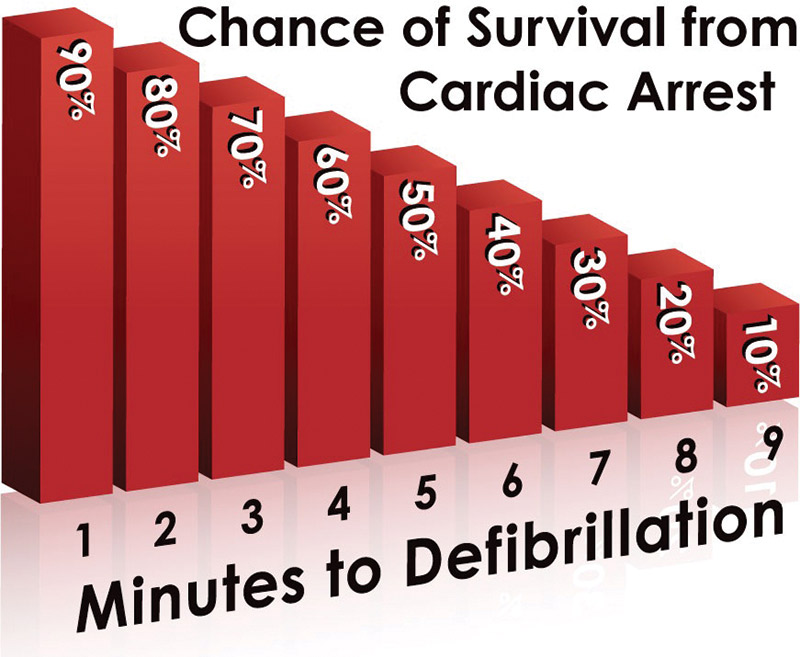
FIGURE 3. Time is very critical from a heart attack to the application of an AED.
At the Delft University’s site, they state: “For the Ambulance Drone, a new type of airframe was developed that is a compact flying toolbox containing essential supplies for advanced life support.” The simulation shown in Figure 3 depicts the Ambulance Drone in use in an emergency situation. Portability and fold-ability as shown in Figure 4 allow the drone to be used anywhere, including indoors.
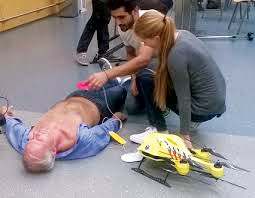
FIGURE 4. Folded AED drone is ready for emergency use.
The first prototype focuses on the delivery of an AED. In the European Union, around 800,000 people per year suffer from a cardiac arrest — an upsetting number considering that only 8% survive this incident. The main reason for this high number of casualties is the relatively slow response time of emergency services (10 minutes). Brain death and permanent death start to occur in just four to six minutes (refer to Figure 2).
Delft University also states: “With the Ambulance Drone, we want to dramatically increase this survival rate. The incorporation of a two-way video supported communication channel in the drone between 112 operators and the first responders will improve first care. Successful AED usage by lay-persons is currently at 20%.
With personalized instructions and communication on the Ambulance Drone, this can be increased to 90%. In short, the Ambulance Drone helps to save lives by extending existing emergency infrastructure with a network of fast and compact UAVs capable of bringing emergency supplies and establishing communication, anywhere.” I’m going to add some thoughts later in this article about coupling another technology to the Ambulance Drone concept.
Delft University has the Right Idea
The previously described scenario has a vivid meaning for me, and possibly for some readers as well. When I was just 14, I got a call that my dad had experienced a heart attack and I was to bring him his heart medicine. Rapidly riding my bicycle to the site where he was already on the ground, I pushed my way through the crowd and attempted to place a nitroglycerine tablet under his tongue. It was to no avail as he died in my arms.
I was finally gently pulled away from him by a caring bystander who saw me desperately trying to revive him with the old style ‘artificial respiration’ that I learned as a Boy Scout.
He was only one block from our doctor’s office, a block from the fire department, and two blocks from our home. AEDs had not been invented yet. It would have been wonderful had an Ambulance Drone AED been available nearby for use by a professional. As a kid who loved to build robots, I had never dreamed of a flying robot to save people.
The American Heart and Stroke Association has these facts stated on their site that stress the importance of close proximity to an AED. “Each year in the US, there are approximately 359,400 assessed Emergency Medical Services (EMS) cardiac arrests outside of a hospital setting and on average, less than 10% of victims survive. Cardiac arrest affects people of all ages, but occurs more commonly in adults with prior heart disease. It will only become more common as Americans age.
In fact, early defibrillation along with CPR is the only way to restore the victim’s heart rhythm to normal in a lot of cases of cardiac arrest. For every minute that passes without CPR and defibrillation, however, the chances of survival decrease by 7–10%.”
Drones will Soon Deliver Packages
Aerial drone package and fast food delivery has been a main topic of robotics news for a while now. Domino’s Pizza has tested aerial drone and wheeled mobile drone robot delivery of their products as Figures 5-7 indicate. The octo-copter drone in Figure 5 looks to be the wave of the future in the United Kingdom, as is the DomiNoDriver scooter in Figure 6.
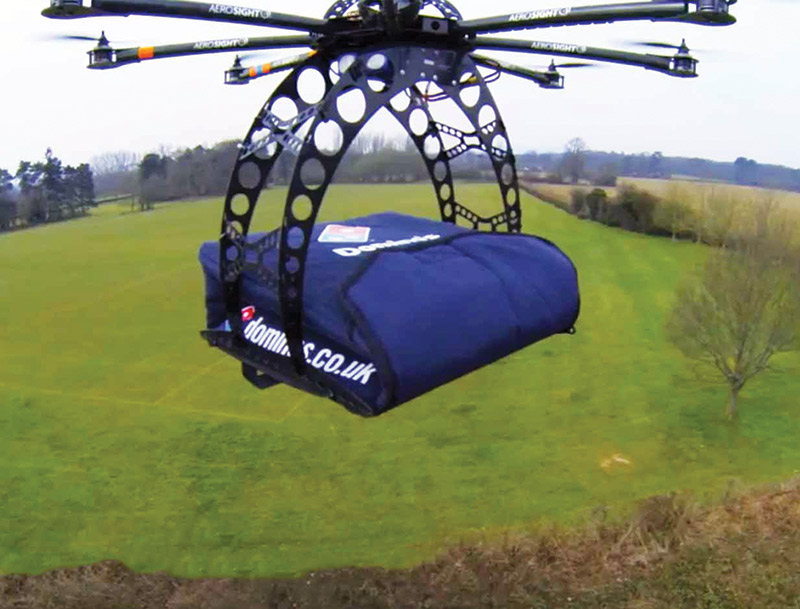
FIGURE 5. Domino’s drone delivers pizza in the UK.
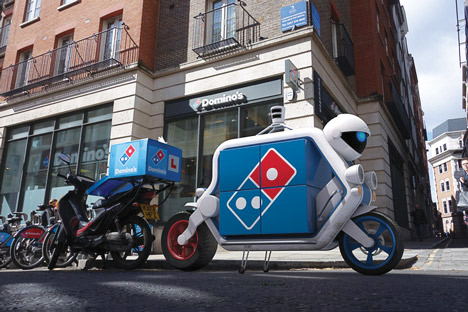
FIGURE 6. Domino’s DomiNoDriver self-driving pizza delivery scooter.
Domino’s in Australia has tried out the mobile ground vehicle shown in Figure 7, which is a bit more practical in my opinion.
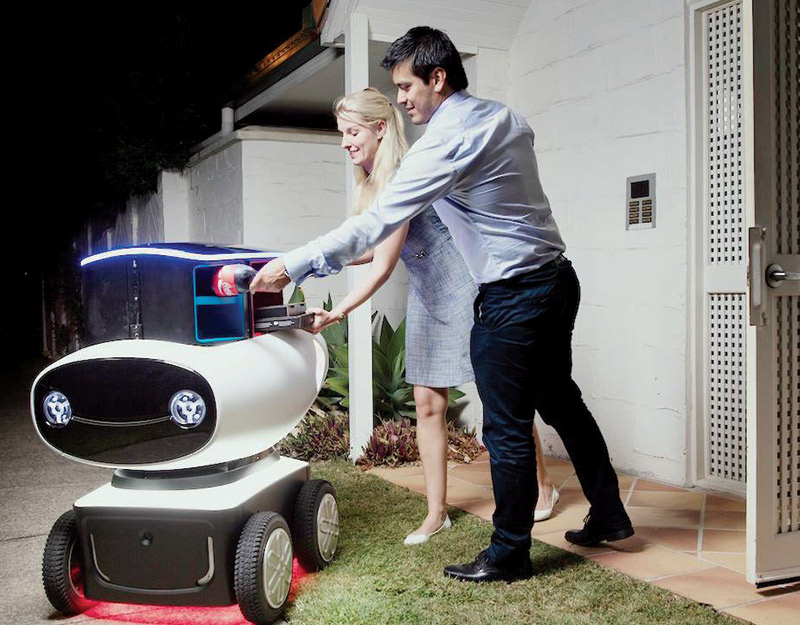
FIGURE 7. Domino’s pizza delivery vehicle.
I’ve always loved new concepts that make use of robotics, but just like a lot of other folks I’m concerned about drones either smashing a pizza when it’s dropped off at a customer’s home or the pizzas being cold because it took too long for the drone to reach the customer.
According to a recent YouGov poll, only 37 percent of Americans believe pizza delivery drones would drop off their order undamaged. Only a third of those surveyed trust that a drone-delivered pizza would arrive at the right temperature. I’ve wondered exactly how an aerial drone would remove a hot pizza from an expensive insulated carrier box without something going wrong.
Two-thirds of those polled said they’d prefer a human delivery person to a delivery drone. However, in the 18-34 age bracket, this group trusted robot delivery of a pizza more than the rest of those surveyed.
CyPhy Works Teams Up with UPS
A recent drone delivery test was performed this past September in Massachusetts by the delivery giant, UPS with the drone shown in Figure 8 that it purchased from Helen Greiner’s CyPhy Works.
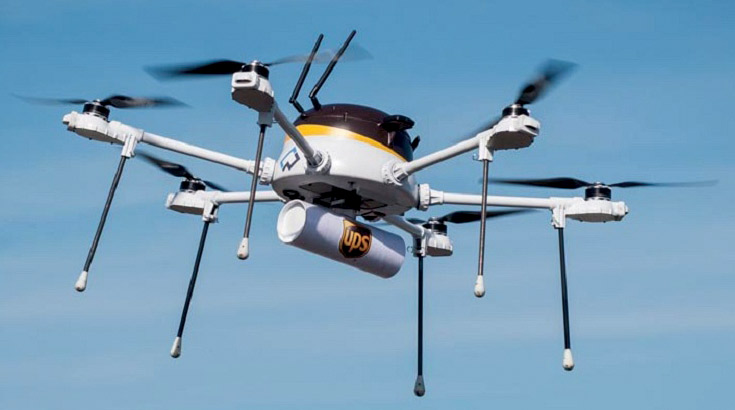
FIGURE 8. CyPhy drone works for UPS.
It turned out to be an eight minute life-saving event. The 42 inch/10 pound drone delivered an asthma inhaler to a child at a YMCA camp on Children’s Island off the coast of Beverly, MA three miles away.
“Delivery drones have taken another step in proving they can safely deliver urgent medicine to hard-to-reach locations,” wrote Steve Crowe on Robotics Trends website. The island is only accessible by boat, and then only for a walk-on passenger (not cars). The drone took about eight minutes, flying at about 22 MPH to reach the camp versus the normal 30 minute boat ride.
Remote locations such as this have long been critical concerns for medical and emergency situations on inaccessible islands. I know this first hand, having lived on Orcas Island off the coast of Washington for a number of years. Neither Orcas Island or any of the four main islands and many smaller of the San Juan Islands have any bridges for mainland access. We had to rely on Med Flight insurance to be helicoptered ‘off island’ in emergencies.
Non-insured flights would have been in the $35,000 category. However, drone flights in the near future might be able to supply on-island doctors with specialized medications, transfer of critical blood tests, and even unique medical instruments.
Are Delivery Drones Safe from Hijacking?
Another issue that has bothered a lot of robot experimenters is what if one of these drones gets ‘captured’ while on a delivery run and sold to an unscrupulous buyer. For the price of a pizza or something inexpensive on Amazon, using a stolen credit card, a bad guy could toss a net over a UAV drone or just scoop up a mobile version and put it into the back of a van, then quickly take it out of town while an accomplice in the back of the van disables the power and removes any tracking devices. The future will offer us a lot of neat things, but along with the future, we will continue to have dishonest people.
Drones Hitching Rides to Increase Range
Amazon has considered the use of trucks or busses to assist their drones to increase the delivery range as a recent patent filing indicates. Tests that began over a year ago show a prototype Amazon drone actually delivering a shoebox to someone’s backyard as seen in Figure 9. The four-prop quad appears to also have a pusher prop in the back.
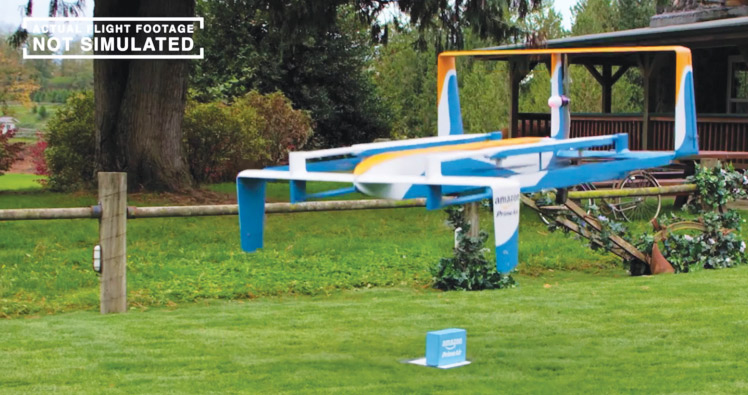
FIGURE 9. Amazon drone delivers a shoebox in a backyard. Note the Amazon target under the box.
As part of the patent filing, they also want to have the option of landing their drones on a truck or bus for a portion of the delivery route. The drone will then depart the vehicle at the nearest point of the route to the customer’s house. Since most present day drones have a limited range, this will not only save energy but quicken delivery times. It will also allow drones with dwindling battery power or with possible technical problems to land back on one of the system’s trucks in emergencies.
As Amazon executives have stated, “There are a variety of factors when deciding whether or not to land a drone on an eligible vehicle, including: vehicle travel path in relation to the package destination; timing of routes versus delivery timeframe; and travel speed of possible landing vehicles. Amazon will develop agreements with transportation and shipping companies that could include compensation in exchange for permission to land drones on vehicles. Drones can use identifying markings and GPS coordinates to find vehicles to land upon.”
Amazon sends a message to a driver when it wants to land a drone on a vehicle and the driver gives permission for the landing and confirms that the drone successfully docked with the vehicle. If a drone’s battery is about to die or some other malfunction occurs, the company would plan for the aircraft to land on the first available vehicle, and then Amazon personnel could set up a meeting with the driver to retrieve it at a set location.The FAA did drop a ‘bombshell’ when it changed drone operation rules to allow only line-of-sight drone control, but Amazon feels that it can prove the safety of its intended services.
Mercedes Vans and Starship Technologies Robot Deliveries
Mercedes Benz’s Delivery Van Division recently began working with a robot company, Starship Technologies to develop a relationship that uses the car company’s vans as ‘motherships’ to bring Starship’s small mobile robots (shown in Figure 10) closer to a local delivery area.
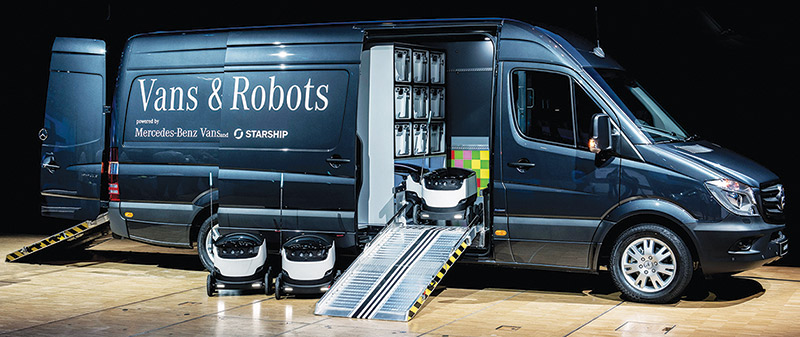
FIGURE 10. Mercedes Benz and Starship Technologies’ delivery robots.
The companies strive to cut down street traffic congestion, create efficient delivery of an order, and cut down on exhaust emissions. “We see a huge potential for robotic delivery systems in the future, and by combining our vans and the robots, we call it the mothership concept,” says Volker Mornhinweg, Head of Mercedes-Benz Vans. The small robotic vehicles can carry up to 40 pounds and complete deliveries within a three mile radius. They move at pedestrian speeds and can maneuver around obstacles and people. Navigation is via GPS and multiple cameras are used to map the vehicle’s intended path. The packages are securely locked within the cargo bay and can only be opened by the intended recipient.
Starship Technologies has also partnered with Switzerland’s postal service, Swiss Post to test the delivery robots in three locations across the country including the capital, Bern. They want to see how effective the robots can be at carrying goods over the last mile of the delivery route.
Combining Truck Delivery Drones
After studying Amazon and Starship’s plans of increasing drone range with the use of vans or buses and the CyPhy Works experiment, I think it makes a lot of sense to use the same technology with AED drone shipments. Of course, on-time delivery of standard packages and pizzas is important, but not nearly as critical as sending a life-saving AED to a remote location. As I’ve stated before, today’s drones have a critical endurance limitation due to battery capacity. If you increase the battery’s capacity, the weight is increased and the carrying capacity of the drone is reduced proportionally. So, absolutely, one of the answers to this dilemma is to shorten the drone’s travel distance by having another vehicle carry the drone to a point as close to the final destination as possible.
Let’s suppose that the 911 emergency network has matured to the point that many local police and government vehicles have an ambulance drone in the trunk. The drone is safely tucked in a plastic case with a cable running from the car’s 12 volt system to a charger built into the case to keep the drone’s and AED’s batteries fully charged. All of the local system’s and fire department vehicles are continually tracked via GPS and locations are updated on an area map in a central computer.
When an emergency call comes into 911 or the app’s control center, the central computer decides which vehicle is closest to the site of the emergency and informs an operator to call the vehicle’s driver. The driver then stops at a clear location, removes the drone from the enclosure, and allows it to take off and go to the site of the emergency — whether that be an inaccessible area or just a rural or urban home or work site.
I am envisioning a larger drone that might carry a small oxygen bottle or a chemical oxygen generator and mask in addition to the AED, as well as a few wound care supplies such as bandages, splints, and topical antiseptics (maybe even an EpiPen as seen in Figure 11; an epinephrine injection device is typically carried by those who have severe allergies for life-critical allergic reactions).
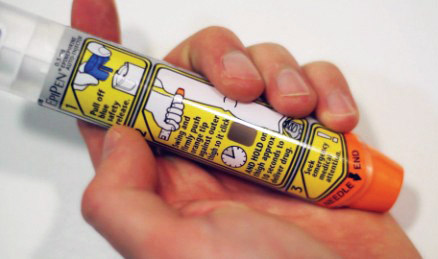
FIGURE 11. An EpiPen is definitely small enough to ride on a drone to a person in need.
Is this just a dream of the future or could it be implemented with today’s technology? It is possible, and one of you could be the force behind the implementation process.
A Useful Assistant for Humans
Notice that I used the word useful in the title above. As I have mentioned many times over the years, well-meaning designers have tried to develop a robotic caregiver that would be the all-in-one device to care for seniors and hospitalized persons. When benevolent thoughts of developing a caregiver robot arise, people first think of help for disabled or hospitalized people and not for seniors living on their own.
However, when a prospective designer begins to analyze the needs that all disabled persons may require, they quickly realize that no single design can meet the unique needs of all disabled persons. On the other hand, a quick analysis will show that most seniors have all their functional physical capabilities, it’s just that these functions do not work as well as they once did. This very large group of people needs physical assistance in daily living.
With the best intentions in mind, the best robot product results so far have been a passive robot that can perform two-way communications with a doctor or other persons, and deliver needed food, and medical supplies and/or medicine. The RP-Vita telepresence robot from iRobot and InTouch Health shown in Figure 12 is a great example of a robot that has proven its usefulness as a nurse or doctor’s assistant in hospital environments.
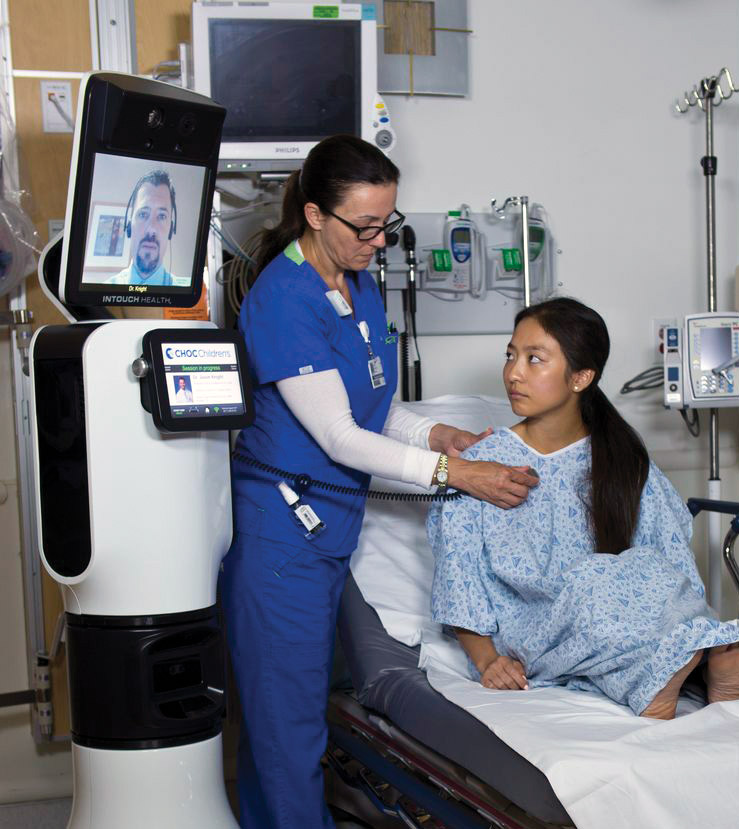
FIGURE 12. Telepresence robot from InTouch Health and iRobot gives doctors access to remote patients.
Hospitals are very busy work environments where any reliable robotic assistance can dramatically cut already very high costs by performing basic needs for the staff. Doctors with a number of patients in multiple areas of a large hospital can ‘see’ and interact with all of their patients through the robot’s cameras and sound system.
A person’s home, on the other hand, usually needs reliable help for just a single individual. Most of this dedicated help is usually physical assistance as mentioned. We can divide physical assistance into two categories: object manipulation for the senior and physical assistance to the person to help them move themselves. It is this latter category that has been the stumbling block of robot designers for decades.
We have all laughed at the TV ads that make fun of an elderly person who has fallen and then calls out through their remote pendant: “Help, I’ve fallen and I can’t get up.” This really is not a comical situation at all, as many people fall each day and cannot get back on their feet or even to a chair on their own. They may live alone and have nobody to assist them from the floor or into and out of a bed, chair, or toilet.
The design stumbling block is not that designers can’t build a robot to assist people in a difficult physical situation; it is the federal safety regulations that are in place to protect purchasers of such a robot from further injuries from the robot itself. The FDA Code of Federal Regulations, part 890, “Physical Medicine Devices,” and part F, “Physical Medicine Therapeutic Devices,” part 890.5050 describe a “Daily Activity Assist Device” category to which such a robot will have to conform.
No manufacturer likes all of the federal requirements for their particular industry, but reputable companies realize that these regulations are there to protect customers. Designers are wary of their robot pinching, dropping, or injuring a patient in any way.
I have spent almost 30 years studying robot designs to give the elderly the pride of independent living. Care facilities are very expensive and home care by professional caregivers is even more costly.
Several years ago, I visited an upscale care facility and interviewed a dozen or so residents about how they might feel if they could continue living in their homes with the help of a personal assistant robot, and most welcomed the possibility; independence and cost were the two main factors. A $30,000 robot that’s about the same price as the car in their garage (that they could no longer drive anyway) would certainly be preferable to paying $5,000 to $10,000 a month for care away from their home. A truly functional and useful robot to assist seniors can be designed and manufactured with today’s technology. Unfortunately, it might be years before costs drop to $30K.
Final Thoughts
The robot shown in Figure 13 is Elektro: Westinghouse’s amazing Moto-Man first seen at the 1939 New York World’s Fair. It truly did amaze the attendees who stood around the company’s exhibit and watched the ‘robot of the future’ talk, move its head, and even smoke a cigarette.
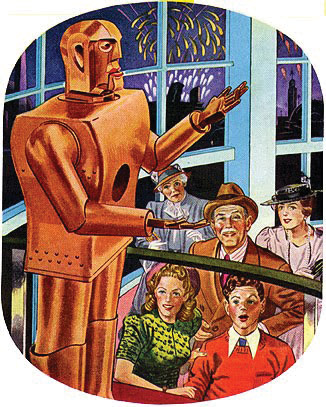
FIGURE 13. The Amazing Elektro from Westinghouse at the 1939 New York's World Fair.
The huge metal robot was held fast to the floor, and though it could shuffle its feet, it was controlled by humans behind the scenes. The ad that appeared in the Saturday Evening Post in the summer of 1939 was directed at ‘modern’ homeowners who were beginning to see so many new helpful electrical appliances designed to assist homeowners.
The future of robotics is anybody’s guess. There are so many advances in AI and cloud computing, facial and pattern recognition, speech recognition, LIDAR and similar smart visual sensors, highly functional robot arms and hands, and even high density power systems that smart personal robots will soon be a reality for all of us. Many household tasks that are quite difficult for present robots such as folding clothes and washing dishes are being simplified, and robot manipulative capabilities are becoming more functional.
From homemakers needing help in household tasks to seniors desiring independent living, robot designers are working hard to meet these needs. When these ‘ends’ finally meet, a Rosie or Jeeves personal robot will begin to appear into homes of the near future. SV
Article Comments